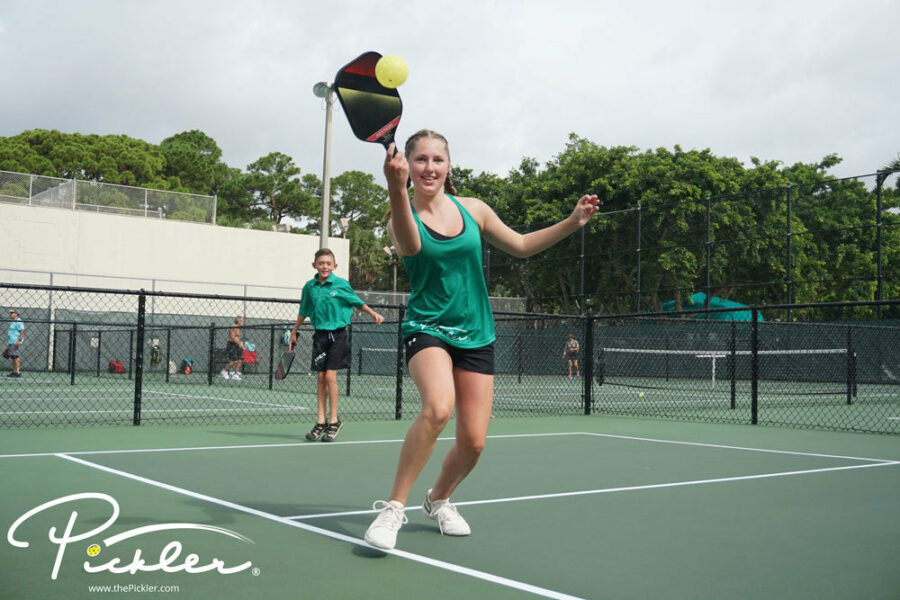The sport of pickleball is as much about strategy as it is about physicality on the court (if not even more about strategy and the mental game). The doubles pickleball team or singles pickleball player that figures out the right strategy first, typically will win the game. And, one element of this pickleball strategy is finding patterns.
There are a lot of repeatable patterns of play on the pickleball court. For instance, returns of serve and third shots will find their way to a particular player or side of the court. From there, pickleball players will fall into a certain pattern of shots in order to amplify their strengths and target their opponents’ weaknesses. In other words, pickleball players will find patterns that they win the majority of, and avoid patterns that they find themselves losing the majority of.
With that said, what are some of these pickleball patterns to watch for? Learn three pickleball patterns of when at the Kitchen line to help you win more points on the court:
- Crosscourt Dinks Until a Pop-Up – A dink is most commonly hit crosscourt (as opposed to straightforward or in the middle of the court). This is because the crosscourt dink gives you the most margin for error, as (1) the lowest part of the net is in the middle; (2) you are hitting into a natural angle; and (3) you have more court space to dink into in your opponents’ side of the Non-Volley Zone. In other words, the crosscourt dink is more forgiving and you do not need to be quite as perfect.

- A pop-up, which would lead to an easy put away for you or your partner. Plus, the pop-up will generally have a lot of options—whether down the line, down the line, or back crosscourt; or
- A premature speed-up that is easily counterattacked or that is an unforced error into the net or out of bounds.

- Sideline-to-Sideline Dinks to Middle Winner – Another common pickleball pattern at the Kitchen line is to spread out the middle of the court. To do this, you will use dinks to both sidelines (and occasionally to the middle). For instance, say you take a dink to the middle of your opponents in doubles pickleball. Both of your opponents take a step toward the middle. When your opponents return the pickleball to you, since they both took a step toward the middle, you now have more room to hit the pickleball toward the sidelines. Then, your opponents will move toward the sideline to return the pickleball. Now, you have even more room in the middle of your opponents because one moved toward the sideline. You could even then dink to the opposite sideline to push your other opponent out of the middle. By spreading your opponents out toward the sidelines, you can open up the middle of the court for a speed-up or put away shot. This is especially true if your opponents do not work well together and do not stay in tandem on the court. So, use those sideline dinks to spread your opponents out and leave you and your partner a winning opening down the middle of the pickleball court.

- Speed-Ups to the Chicken Wing – If you are not a dinker, then you may prefer a pattern that allows you to speed up the pickleball. One such pattern is to find your opponents’ paddle-side shoulder and speed up the pickleball toward that spot. This will have the effect of causing your opponent to “chicken wing” in order to return the pickleball. The paddle-side shoulder is a difficult spot to defend as it is the transition point between a backhand shot and a forehand shot. In other words, your opponents will have trouble determining whether to hit a backhand or a forehand, causing confusion and errors.

However, this pickleball pattern does not stop at the speed-up to the “chicken wing” area. Rather, the speed-up shot is a set-up shot. The speed-up to the paddle-side shoulder is designed to catch your opponents off guard and induce a pop-up, which is then sets you up for the winning shot. So, this pattern is really a 1-2 punch. Speed up the pickleball to the “chicken wing” and then be ready for the put away on the next shot.
With these pickleball patterns, you may notice a common theme… you do not typically win a point in just one shot. Rather, it is important to create and craft a point using multiple shots to set up your eventual winning shot. And, by using the patterns like those described above, you will set yourself up for your eventual winning shot.
So, know your strengths and your partner’s strengths and identify your opponents’ weaknesses. Once you do that, you can craft a point using patterns that highlight your and your partner’s strengths and expose your opponents’ weaknesses.
With that said, don’t forget to mix it up and remain unpredictable. Pickleball is a game of adjustments, so it is important to have a few patterns in your playbook. Otherwise, your opponents may figure out your pattern and use it against you.




